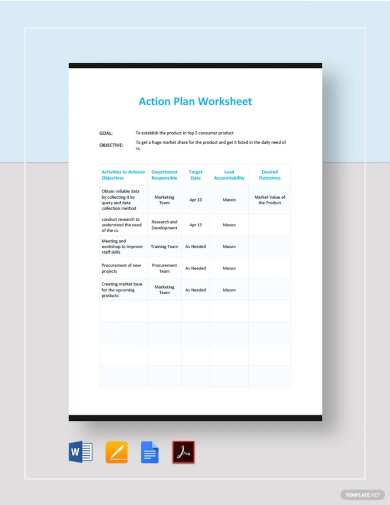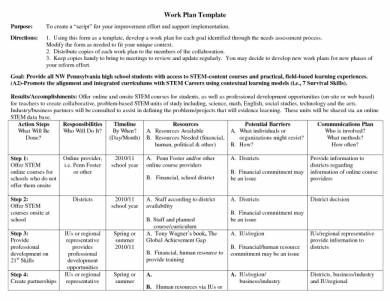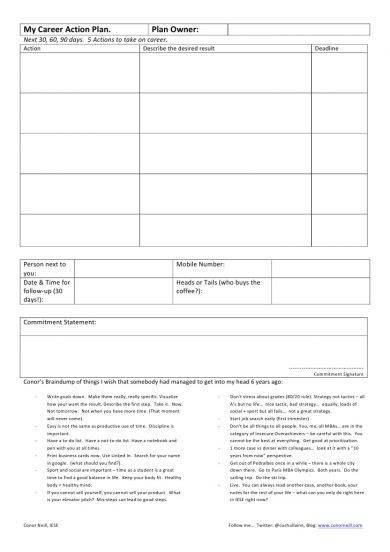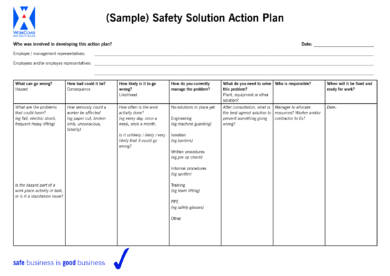31+ Work Action Plan Examples to Download
In our daily lives, irregardless of what we do or how old we are, we often find ourselves facing tasks that may require more focus, effort, and planning than others. In these cases, simply jumping into the task may be effective, but creating a work action plan before doing so can guarantee a more goal and quality-centered output.
Basically, work action plans are a more extensive form of a step-by-step process that visionaries can use to realize their general plans. This is very much effective for complex undertakings, especially those that involve groups or teams of more than one working individual.
Work Action Plan Example
Remote Work Action Plan Template
Action Plan Work Sheet Template
Employee Engagement Action Work Plan Template
Action Plan for Understanding Youth Work
Work action plans can help you create a more tangible picture of the long and tedious journey you are about to embark on. By doing so, your objectives and the paths that lead to it will be solidified, reducing the chances of you or your organization being lost along the way. You may also see marketing action plan examples.
A work action plan will enable you to fully grasp what you are aiming for and the people you will need to achieve your goals. Ideally, a work plan will also include your estimated time for accomplishing your objectives (a couple of months?), and the resources you will need to do it (time, money, and connections).
Draft Action Plan
Personal Action Plan
Why Are Work Action Plans Needed?
You might be thinking that creating a work action plan is additional work you definitely don’t need. Why would you need to make an exhausting outline if you could just go right into the activity, right? WRONG. As the timelessly accurate adage goes, “People don’t plan to fail. Instead they fail to plan.” You may also see employee action plan examples.
Assuming that the saying hasn’t convinced you enough, here are further reasons why you should definitely have a work action plan for your next task:
1. Because you don’t want to fail, enumerating all the steps you need to take to ensure your success is important. This includes creating a general action plan that will lead you and your team to the realization of your visions, not minding the additional effort that this will require from your part because the end product will be worth it.
2. Work action plans also add credibility to your organization. (If you are flying solo, a work action plan will show how organized and dedicated you are in achieving your goals.) Having a concrete plan that you can show to those who are cynical about your success will show them that you and your whole team are well-coordinated in being a goal-centered organization. You may also like sales action plan examples.
3. A work action plan can help you look for errors. No plan is blameless, we all agree with that. However, you can make yours as foolproof as possible by laying it out, every tiniest detail of it, and studying it for possible sources of setbacks. Work action plans actualize what used to be just ideas.
By doing so, you can have a tangible object you can study and evaluate. In comparison to simply working and waiting for problems when they come, work action plans are undeniably more effective.
4. To understand limitations. Despite the unique and talented set of workmen you have at your disposal, your team is still bound to have deficiencies. By creating a work plan and assigning tasks before you start working on your goal, you can recognize the roles that your team can play and those that they can’t. By doing so, you can avoid tasks that are unreachable which can only serve as obstacles in your way.
5. Working with a team has its perks. However, it also has its struggles and difficulties. A common one is having to make everyone function based on what’s expected of them. People get confused. That’s unavoidable, and you can’t hold them against that flaw (which you are also guilty of, surely).You may also check out SMART action plan examples.
Creating a work action plan won’t keep your team from being unsure of what to do, nor will it force them to carry out their tasks.
However, action plans can serve as their constant guide to keep them on track. It can also help them understand their roles because it will all be stated plainly and explained thoroughly in the action plan. These can also serve as effective reminders to your team members of the things they still have to do, which is just as effective as you yelling orders at them. You might be interested in team action plan examples.
Work Plan Template
Work Action Plan Example
Tabular Action Plan
When Should You Create a Work Action Plan?
Since you are still reading this article, it is safe to assume that you have been convinced of the importance of action plans, the roles they play, and your high level of need for it. For this part, we will now move on to understanding and recognizing the appropriate time that an action plan should be created. You may also see corrective action plan examples.
Ideally, action plans should be created six months to a year after an organization has been established. It automatically comes right after knowing the vision and mission statements your group will live by. Through a work action plan, your team will now have a blueprint to use as reference for the things that need to get done.
However, work action plans can also be used for smaller scale goals that perhaps only affects a certain area of your organization, or a specific department. In that case, you can create a work action plan right after you have come up with a target. You may also like research action plan examples.
After knowing where you want to go, create a map of how you can get there. This is the purpose that a work action plan will play for you, whether or not you are working with a team or doing all the dirty deeds on your own.
Work Action Plan Sample
Corrective Work Action Plan
Example Action Plan
An important thing to remember about work action plans is that they are never constant. On the contrary, they need constant tweaking and adjustment. You can’t simply create a work action plan and then decide that your whole organization will now follow it step by step. Your job will not end there. You may also see 90-day action plan examples.
You have to supervise the whole process and always be on guard for areas of improvements. A work action plan, although technically finished, is still a work in progress just like you, your team, and your goal. It will only end when you have reached your target. You may also like strategic action plan examples.
Personal Work Action Plan
University of Kent Action Planning Steps
Personal Career Action Plan
Things to Do before Making a Work Action Plan
You must be tired by now of all these preliminaries and suspense but we can’t go straight to discussing how to create a work action plan because there are elements that need to be prepared before doing so:
1. You need to have a clear objective.
How can you arrive at a place when you don’t even know where you want to go? This element is crucial. You need to fully understand exactly where you want your action plan to take you.
2. You need to know what benefits you and your organization will get out of your objective.
Monetary gain? A good public image? Whatever it is, you need to know what all your efforts will be for. If you can’t pinpoint at least one, then your objective isn’t really worth all that hassle, is it? Setting your team’s eyes on your professional goal is important. But encouraging them to look at the positive products of that goal is enough to make them understand just what all that noise is for.
3. You need to recognize what you need to do right now.
Otherwise, you will find yourself, halfway into your action plan, facing some sort of crisis you could have done better to settle before you started with the whole endeavor.
Budget is a common issue. Before you start working toward your goal, estimate first if you have enough funds to do it. Although it may seem like a simple problem, it is a major complication that can interrupt or even destroy all of the improvements you have already accomplished. You may also see budget action plan examples.
4. Create an overview of efforts you need to exert into the completion of your goals.
Just an overview, look at your goal and identify what you need to do to achieve it. For example, you have a personal goal that involves reading 100 books a year. For this goal, decide on what you need to do to achieve exactly that. How many books will you have to read in a month or a week to get to your target number and maybe exceed it even? By doing this, you will understand just how much you need to do to get what you want.
5. Prepare a reward for every step accomplished.
The road toward achieving a goal is long and steep. Which means that if you only focus on the end game and only recognize the big achievements, you will find yourself disheartened by the long way you still have to go and the number of things you still have to do. You may also like career action plan examples.
To avoid this, notice and appreciate the little achievements and prepare small rewards for them. Whether you are working as a group or alone, recognizing the tiny milestones you have reached is important to keep you motivated and determined to reach the end game. You may also check out corrective action plan examples.
Even rewards like food (nobody can say no to pizza) for every level or step in the work action plan that you and your team accomplishes can do a lot to boost your members’ enthusiasm for the job.
6. Consider the possible problems you will meet.
In identifying possible barriers, you need to take into the equation the abilities of your workforce and the external forces that are out of your control.
Aside from financial constraints, this may include the lack of other vital resources such as important connections, or the productivity of your teammates. These mishaps are unavoidable, but since they can be foreseen, you can still equip yourself with the necessary means to overcome them when they come. You might be interested in teacher action plan examples.
7. Buy a journal or a notebook you can use to update your progress with.
If you are one of those precious old school hearted ones who love handwritten things, get yourself some quality piece of stationery that you will use when you and your team start carrying out the steps in your work action plan. This will help you keep up with the improvements you accomplish along the way which is vital in knowing how well your team is coping. You may also see asthma action plan examples.
Personal Action Plan Format
Work Action Plan Template
Action Plan Work Sheet
Career Action Plan
Five Elements of a Good Work Action Plan Objective
Your simple action plan will only be as good as your objective. Without a clear picture of what you want to accomplish, exerting the right amount of effort and applying the right approaches to get there will be impossible. Needless to say, it is a major game changer for everyone involved. Hence, here are a few elements you should watch out for when deciding on which objective you should set your work action plan toward:
1. Specific.
Your objective must be well-defined. Failure to do so impresses that even you are not sure about the goal. It’s not really that hard to be literal when making an objective. You state what you want to get done in the simplest way. For example, “Earn $100 million of revenue” or “Find new investors.” By stating your objective in that manner, there will be no space for vagueness and ambiguity. You may also see project action plan examples.
2. Measurable.
Numbers. As difficult they may seem to others, they are an essential part of business. Your goal should not only be literal, it should be concrete. There must be numbers and percentages attached to your goal (like the first example in the previous element).
3. Attainable.
What use is a goal that is too far-fetched to be realized? When talking about objectives, they should be those that you are sure your group can achieve. It won’t matter how long as long as you get there. A common mistake most organizations make, especially the smaller ones, is setting goals that are too difficult, and projecting numbers that are too big. Dream big—as big as you possibly can—but keep a firm set of feet rooted in reality.
4. Relevant.
Since you are not the only company in the field, you must take into consideration your competitors. You are part of something bigger. There are many things you need to consider even for setting personal goals. For example, you are aiming for $100 million worth of revenue in, say, 1 month. What if 3 other booming competitors opened? Your objective will no longer be relevant to the present state of the market. You may also like employee corrective action plan examples.
5. Time-based.
There’s a 90% chance that your goal just won’t get done if you don’t set a deadline for it. We will discuss further on the importance of this element below.
Quarterly Action Plan
Sales and Marketing Action Plan
Initial 90 Day Action Plan
Traffic Light System Work Action Plan
Steps in Creating an Action Plan
When you get all those preliminary things (stated above) done, you are now ready to start creating your work action plan. Here are the steps you need to conduct:
1. Gather your teammates.
If you are working with a group, this is a step you should take care to follow. Obviously, you are not the only one who will be working toward your target, so it makes a lot of sense that your opinions and strategies are not the only ones that the whole team will obey. You may also see affirmative action plan examples.
Besides, more than a pair of brains conjuring ideas is always going to be better than just one cerebrum thinking for the whole team. But you don’t have to invite every member in your organization to brainstorm especially if you’re part of a big group because the scene will just be plain chaotic. Pick out individual leaders in your organization, those who can help you in guiding the others to follow and convene about your work action plan. You may also like weekly plan examples.
2. Discuss your goals.
If you recall, we’ve already discussed the importance of knowing your objectives before you start creating your work action plan. Well, it’s now time to put them to use. Usually, a work action plan is only centered on one goal. (However, these goals may cause ripples of sub-products you can also make use of.) Once you and your team agree on what that goal is, you can proceed to creating steps that can lead you to it. You may also check out risk plan examples.
3. Create sub-goals.
Or simply break down your main goal into milestones that you and your team can accomplish quicker. Some teams may consider sub-goals unnecessary because why would you create small problems to address? However, sub-goals are not new but smaller problems. They are your big problem divided into parts until they become small. The concept of a goal often becomes too daunting for some teams. You might be interested in daily plan examples.
The first few months will be all enthusiasm and dedication, but sooner or later, people just lose sight of what they are working toward, and this will be a major problem for you. By creating smaller benchmarks, your team will feel as if they are continually achieving something big and important, and even if they lose sight of the bigger goal, it’ll be fine since they are still unknowingly working on turning points that can lead them there. You may also see quality plan examples.
4. Determine what you need to do to achieve your goals.
For this part, you will have to create the steps you will need to take to accomplish your target. For example, your goal is a 10% increase in sales.
How do you think will you accomplish that? Your first step can be having 2 or 3 sets of targeted audiences. Your second step can be creating different tools fit for the crowd you are aiming for, and so on. These steps will make your goal seem more reachable because you have a systematic plan for it. You may also see transition plan examples.
Without steps, you and your team can stumble and bumble for months without having attained anything concrete because you don’t really know how to get to where you want. Make your steps as detailed as possible. The more comprehensible they are, the easier they can be executed by your group. You may also like job plan examples.
5. Put a date on it.
If you are working toward a long-term plan, your group may slack off in the middle of it thinking that they still have a long time to get things done. Change that perspective with a deadline. (Nothing boosts productivity like this one.) Especially if you have successfully created sub-goals, limiting the amount of time that your group can work on that can help you make sure that your tiny targets will be achieved when you need them to be. You may also check out advertising plan examples.
Having a daily goal will also help you track your team’s progress. However, this can be an added burden to them especially if they have other things they need to work on. Assuming that you know your group and their needs very well, use this knowledge to create a timeline that will work for them.
6. Review your work action plan.
You now have a goal, steps to be taken to achieve that goal, and a time limit for doing so. These three are the most important parts of your work action plan. Evaluate each one for you to know if they are enough to help your team achieve its goal. This step will be particularly easy if you have the solicited opinions of others in your team. You might be interested in event plan examples.
7. Keep everyone fully informed.
Your team, not just those who helped you create your action plan but every single member of your group, needs to know if they are actually making progress or not. Also, by keeping them informed, they will see the things they have accomplished and the things that they haven’t. The latter can lead to pride and satisfaction in their collaborative efforts, and the latter can inspire them to work harder. Either way, it’s a good source of motivation. You may also see annual plan examples.
8. Follow through.
Since you are the one creating the work action plan, you also have a responsibility of keeping track of everyone’s work including your own. Setting a goal will be deemed useless if nobody is willing to go through all the exhausting efforts of accomplishing it. This last step is the most important of all. As long as you and your team are still driven to work for the improvements you want to see in your group, then you’ll go a long way. You may also like company plan examples.
Departmental Level Work Action Plan
Template Work Action Plan
30, 60, 90 Day Work Action Plan
S.M.A.R.T. Goal Action Plan
Criteria for Writing Work Action Plans
Work action plans don’t exactly have standards. They don’t follow rigid rules and whatnots. However, you will still have to assess your basic action plan for you to determine if it is thorough enough to help you reach your goals. These criteria will help you with that. If your action plan misses at least one of the following, it means that you have to do some serious improvements to it.
1. Is your action plan complete?
Work action plans are mainly characterized by exhaustive steps that you and your team can follow to reach a goal. This is also the main element that you can focus on to help you assess the completeness of your action plan. If your goal is multi-tiered, each level should include unique steps and so on. Without this characteristic, your action plan cannot be considered complete. You may also see personal plan examples.
2. Is your action plan clear?
An action plan, aside from consisting of the steps that a team need to take to reach their goal, should also include proper designation of tasks. Especially for groups made up of many people, each one should be properly informed of the roles that they are meant to play in the fulfillment of the team initiative. Each one in the team has responsibilities and it is a part of the functions of an action plan to brief them about it. You may also like financial plan examples.
3. Is your action plan current?
Work action plans need to be regularly updated. Whether it is for goals that take a long time (perhaps a couple of months to a year or more) to accomplish, or those that are more short-termed, action plans needs are in a constant state of improvement. This is because changes and new discoveries are always present during the process.
For example, you already have polished the steps you are going to use for an objective. But then halfway into implementing it, you discover that the next step is no longer appropriate to the developments that the team has already achieved. The action plan will then need to be updated from that step onward. Changes in resources and manpower may also be catalysts you need to look out for. You may also check out assessment plan examples.
Sample Safety Solution Action Plan
Extensive Work Action Plan
Business Work Action Plan
Long-Term Work Action Plan Template
Steering an entire organization consisting of unique (often hardheaded) individuals toward one target is a difficult task indeed. Even with multiple leaders, the act can still be daunting. Having a work action plan prepared will not assure you that your team will obey your every word. However, it can guarantee you that they will no longer feel the need to because they will already know what to do.


































